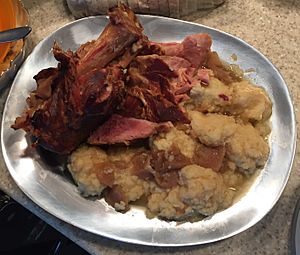Schnitz un knepp facts for kids
 |
|
| Place of origin | United States |
|---|---|
| Region or state | Pennsylvania |
| Main ingredients | Ham or pork shoulder, dried apples, flour, sugar, milk, more |
Schnitz un knepp (pronounced "snitz-en-nep") is a tasty and traditional main dish from the Pennsylvania Dutch people in the United States. It's a warm, hearty meal that combines ham or pork shoulder with dried apples and soft, fluffy dumplings. It's a favorite in many rural families, especially when the weather turns cold.
Contents
Discover Schnitz un Knepp: A Pennsylvania Dutch Treat
Schnitz un knepp is a special dish that brings together a few simple ingredients to create a delicious meal. The name itself tells you what's inside!
What's in a Name?
- Schnitz means "dried slices of apples." These aren't just any apples; they are specially dried to preserve them.
- Knepp means "buttons" in German. This name refers to the small, round dumplings that are a key part of the dish.
A Taste of History: How This Dish Began
This comforting meal became popular in the early 1800s. This was after a famous person named Johnny Appleseed planted many apple orchards across Pennsylvania, Ohio, and Indiana. At that time, people couldn't easily can fruits in jars like we do today. So, they dried their apple harvests to save them for later. These dried apple slices were called "snitz."
The apples Johnny Appleseed planted were often small and a bit tart. But drying them made their natural sugars stronger, turning them into a sweet treat during long, cold winters.
Making Schnitz un Knepp: Ingredients and Steps
Schnitz un knepp is known for its long cooking time, which makes it a perfect dish for winter. The main parts of the dish are the meat, the dried apples, and the dumplings.
The Dumplings (Knepp)
The dumplings, or "knepp," are usually made from a simple mix of:
Sometimes, people make a different kind of knepp using yeast instead of baking powder, and without sugar.
The Meat and Flavor
The dish traditionally uses "country ham," which is a type of ham preserved with salt. However, other kinds of pork, like honey ham or pork shoulder, can also be used.
Some cooks like to add extra flavors to their Schnitz un knepp. They might include:
- Onions
- Potatoes
- Cloves
- Cinnamon
- Brown sugar
All these ingredients cook together slowly, creating a rich and comforting meal that has been enjoyed by families for generations.

